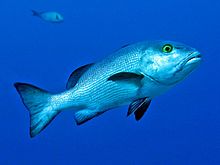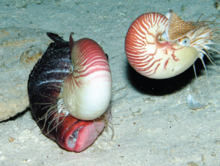| Lutjanus bohar | |
|---|---|

| |
| Lutjanus bohar from French Polynesia | |
| Conservation status | |
 Least Concern (IUCN 3.1) | |
| Scientific classification | |
| Domain: | Eukaryota |
| Kingdom: | Animalia |
| Phylum: | Chordata |
| Class: | Actinopterygii |
| Order: | Acanthuriformes |
| Family: | Lutjanidae |
| Genus: | Lutjanus |
| Species: | L. bohar |
| Binomial name | |
| Lutjanus bohar (Forsskål, 1775) | |
| Synonyms | |
| |
Lutjanus bohar, the two-spot red snapper, the red bass, twinspot snapper or bohar snapper, is a species of marine ray-finned fish, a snapper belonging to the family Lutjanidae, not to be confused with the unrelated Australian snapper. It has a wide Indo-Pacific distribution.
Taxonomy
Lutjanus bohar was first formally described as Sciaena bohar in 1775 with no type locality given, although it is thought to be the Red Sea. The description is attributed to the Finnish-born Swedish explorer Peter Forsskål by FishBase, but the Catalog of Fishes attributes as follows
“Fabricius in Niebuhr (ex Forsskål) 1775:46, xi [Descriptiones animalium (Forsskål)”
Catalog of Fishes then states that the valid binomial is Lutjanus bohar (Fabricius, 1775).
The specific name bohar is the Arabic word used for this fish in the Red Sea.
Description
The two-spot red snapper can reach a length of 90 cm (35 in), though most do not exceed 76 cm (30 in). The greatest recorded weight for this species is 12.5 kg (28 lb). These large reddish tropical snappers show darker fins, a rounded profile of head and a groove running from the nostrils to the eyes. They have 10 dorsal spines and 3 anal spines. Juveniles and some adults have two silvery-white spots (hence the common name) on the back close to their dorsal fins, while larger adults lose the spots and become mostly red. Large adults may cause ciguatera poisoning.
This species is a commercially important species and is also sought-after as a game fish.
Biology

It is a long-lived and slow-growing species which reaches maturity at 8–9 years, and the oldest recorded individual is 56. These fishes are carnivorous, mostly feeding on other fishes, crustaceans and molluscs.
Adult snappers often form large schools on the outer reefs or above sandy areas, mainly to form spawning aggregations. Small brownish juveniles mimic damselfishes of the genus Chromis in order to approach their prey.

The chambered nautilus, Nautilus pompilius, is known to scavenge deceased snappers. A pair of nautiluses recorded feeding on a snapper at 703 metres below the surface constitutes the deepest recorded sighting of any nautilus species.
Distribution
This species is native to the Indian Ocean. It is widespread in the Indo-Pacific from the east African coast, north to the Red Sea, to the western Pacific Ocean, north to the Ryukyu Islands, south to Australia.
Habitat
It is a coral reef inhabitant, being found at depths from 4 to 180 m (13 to 591 ft), though usually between 10 and 70 m (33 and 230 ft).
Bibliography

- Allen, G.R., 1985. FAO Species Catalogue. Vol. 6. Snappers of the world. An annotated and illustrated catalogue of lutjanid species known to date. FAO Fish. Synop. 125(6):208 p. Rome: FAO.
- Frimodt, C., 1995. Multilingual illustrated guide to the world's commercial coldwater fish. Fishing News Books, Osney Mead, Oxford,. 215 p.
- Fenner, Robert M.: The Conscientious Marine Aquarist. Neptune City, USA: T.F.H. Publications, 2001.
- Helfman, G., B. Collette y D. Facey: The diversity of fishes. Blackwell Science, Malden, Massachusetts, USA, 1997.
- Hoese, D.F. 1986: . A M.M. Smith y P.C. Heemstra (eds.) Smiths' sea fishes. Springer-Verlag, Berlin, Germany.

- Maugé, L.A. 1986. A J. Daget, J.-P. Gosse y D.F.E. Thys van den Audenaerde (eds.) Check-list of the freshwater fishes of Africa (CLOFFA).
- Moyle, P. y J. Cech.: Fishes: An Introduction to Ichthyology, 4th. Ed., Upper Saddle River, USA: Prentice-Hall. Año 2000.
- Nelson, J.: Fishes of the World, 3rd ed.. New York: John Wiley and Sons.
- Wheeler, A.: The World Encyclopedia of Fishes, 2nd. Ed. London: Macdonald. 1985.
References
- ^ Russell, B.; Smith-Vaniz, W.F.; Lawrence, A.; Carpenter, K.E.; Myers, R. (2016). "Lutjanus bohar". IUCN Red List of Threatened Species. 2016: e.T194363A2321975. doi:10.2305/IUCN.UK.2016-3.RLTS.T194363A2321975.en. Retrieved 19 November 2021.
- ^ Froese, Rainer; Pauly, Daniel (eds.). "Lutjanus bohar". FishBase. February 2021 version.
- ^ Eschmeyer, William N.; Fricke, Ron & van der Laan, Richard (eds.). "Species in the genus Lutjanus". Catalog of Fishes. California Academy of Sciences. Retrieved 4 June 2021.
- Christopher Scharpf & Kenneth J. Lazara, eds. (5 January 2021). "Order LUTJANIFORMES: Families HAEMULIDAE and LUTJANIDAE". The ETYFish Project Fish Name Etymology Database. Christopher Scharpf and Kenneth J. Lazara. Archived from the original on 12 April 2021. Retrieved 4 June 2021.
- ^ Bray, Dianne. "Red Bass, Lutjanus bohar". Fishes of Australia. Archived from the original on 22 February 2017. Retrieved 29 September 2014.
- Steve Waters (19 February 2020). "Fishing for Red Snapper Experts explain how to catch red snapper". Sport Fishing Magazine. Retrieved 4 June 2021.
- Dunstan, A. J.; Ward, P. D.; Marshall, N. J. (2011). "Vertical distribution and migration patterns of Nautilus pompilius". PLOS ONE. 6 (2): e16311. doi:10.1371/journal.pone.0016311. PMC 3043052. PMID 21364981.
External links
- Animal Diversity Web
- Photos of Lutjanus bohar on Sealife Collection
| Taxon identifiers | |
|---|---|
| Lutjanus bohar | |